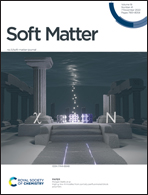Tunable shape memory properties of highly stretchable poly(ester urea) random copolymers based on α-amino acids†
Abstract
The exploration of biodegradable polymers with shape memory effects (SMEs) holds great promise in biomedical fields. Revealing the relationship between the SMEs and polymer structures not only contributes to interpreting the SME mechanisms, but also prompts the customization of materials properties for specific requirements. Herein, we developed a series of poly(ester urea) (PEU) random copolymers composed of two different diamine monomers based on L-alanine and L-valine, respectively. It was shown that the shape memory performance of the PEU copolymers strongly depended on the composition of two different diamine monomers in the PEU copolymers and other physical properties. This tunability likely arose from the change of polymer chain mobility and crystallinity, which were impacted by the choice of α-amino acids. Intriguingly, thin films of the PEU copolymers exhibited a high strain at break of 347–743% around the physiological temperature (35 °C). Moreover, the random copolymerization of two different sorts of diamine monomers has been demonstrated as a facile approach to precisely tailor the physical properties of the PEUs according to custom needs.



 Please wait while we load your content...
Please wait while we load your content...